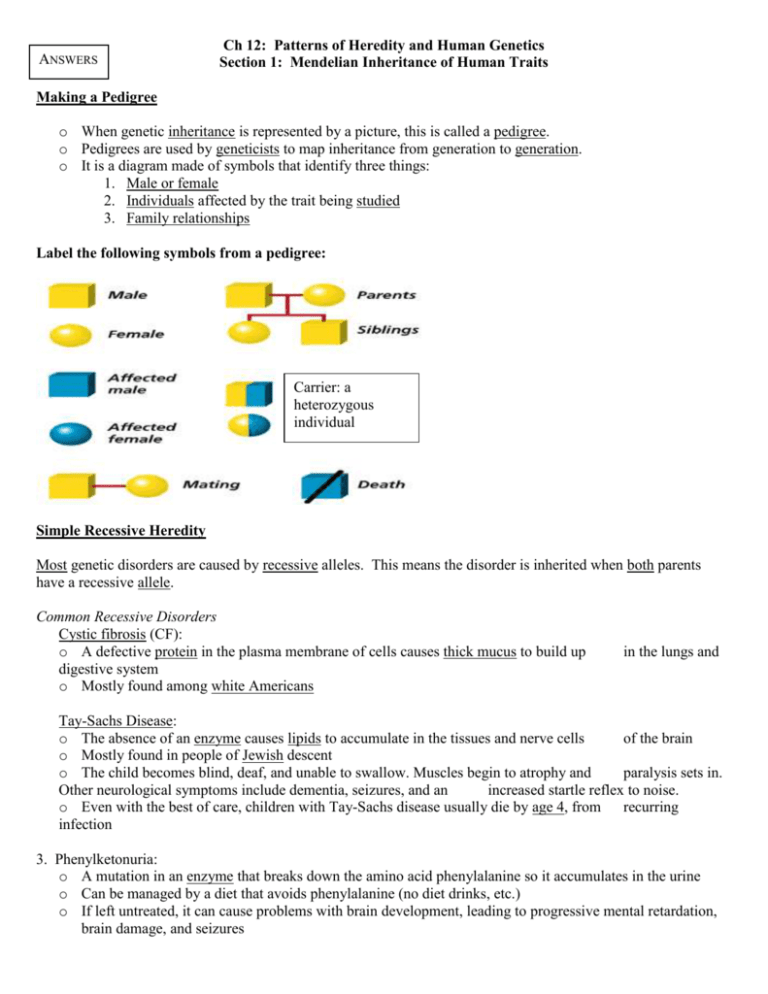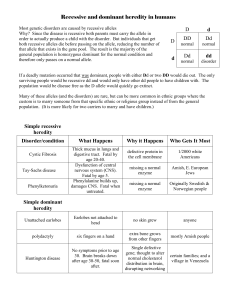Ch 12: Patterns of Heredity and Human Genetics
advertisement

ANSWERS Ch 12: Patterns of Heredity and Human Genetics Section 1: Mendelian Inheritance of Human Traits Making a Pedigree o When genetic inheritance is represented by a picture, this is called a pedigree. o Pedigrees are used by geneticists to map inheritance from generation to generation. o It is a diagram made of symbols that identify three things: 1. Male or female 2. Individuals affected by the trait being studied 3. Family relationships Label the following symbols from a pedigree: Carrier: a heterozygous individual Simple Recessive Heredity Most genetic disorders are caused by recessive alleles. This means the disorder is inherited when both parents have a recessive allele. Common Recessive Disorders Cystic fibrosis (CF): o A defective protein in the plasma membrane of cells causes thick mucus to build up digestive system o Mostly found among white Americans in the lungs and Tay-Sachs Disease: o The absence of an enzyme causes lipids to accumulate in the tissues and nerve cells of the brain o Mostly found in people of Jewish descent o The child becomes blind, deaf, and unable to swallow. Muscles begin to atrophy and paralysis sets in. Other neurological symptoms include dementia, seizures, and an increased startle reflex to noise. o Even with the best of care, children with Tay-Sachs disease usually die by age 4, from recurring infection 3. Phenylketonuria: o A mutation in an enzyme that breaks down the amino acid phenylalanine so it accumulates in the urine o Can be managed by a diet that avoids phenylalanine (no diet drinks, etc.) o If left untreated, it can cause problems with brain development, leading to progressive mental retardation, brain damage, and seizures Simple Dominant Heredity Dominant disorders are inherited as Mendel’s rule of dominance predicted: Only one dominant allele has to be inherited from a parent Common Dominant Traits & Disorders Simple Dominant Traits: 1. Cleft chin 2. Widow’s peak hairline 3. Unattached earlobes 4. Almond shaped eyes 5. Thick lips Disorders: Huntington’s Disease o A lethal genetic disorder that causes certain areas of the brain to break down o Does not occur until 30-50 years of age so this is why it can be passed along o There is a genetic test that can test the presence of the allele…would you want to know? Complex Patterns of Heredity o Most traits are not simply dominant or recessive 1. Incomplete dominance: when neither allele for a trait is dominant over the other…instead they blend together - Red flower color is dominant & white flower color is recessive - If they are crossed, you can get pink colored flowers - Example in humans: straight hair + curly hair = wavy hair 2. Codominance: when alleles are expressed equally so both alleles are dominant - Black feather allele: FB - White feather allele: FW - Black & white: FBFW - If a black chicken is crossed with a white chicken, all offspring will be speckled - Example in humans: sickle-cell anemia and blood types 3. Polygenic inheritance: when a trait is controlled by two or more genes (instead of genotype Aa, it could be AaBb or AaBBCcDDEe, etc) Examples: height, eye color, skin color, & blood type 4. Sex-linked traits: when traits are controlled by genes located on sex chromosomes - X-linked disorders: generally passed on from mother to son o The genetic abnormality is found on the X chromosome o Females are XX, males are XY o If a female has a normal X, it would be dominant over the defective X o In males, it will not be masked by a corresponding dominant allele because they have a “Y” chromosome o Examples: hemophilia & Lesch-Nyhan syndrome - Y-linked disorders: only passed on from father to son o Examples: excessive hair growth of the ears & male infertility







